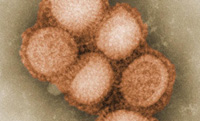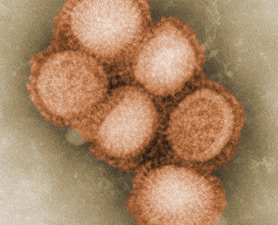Do we need to worry about a rampant H1N1 this flu season? Probably not, say experts. Then again, they can't rul e anything out.
e anything out.
Last year around this time, the H1N1 influenza virus held the nation in a low-grade state of panic. Healthy young people were dying at unusually high rates. Thousands of others ended up in the hospital. The vaccine remained scarce for months.
Do we need to worry about a rampant H1N1 this flu season? Probably not, say experts. Then again, they can't rule anything out.
Last year around this time, the H1N1 influenza virus held the nation in a low-grade state of panic. Healthy young people were dying at unusually high rates. Thousands of others ended up in the hospital. The vaccine remained scarce for months.
Since then, memories of the pandemic have faded. But as the new flu season approaches, concerns have returned . Where did the virus go? Is it coming back? And should we start hunkering down in our homes to avoid another public health emergency?
. Where did the virus go? Is it coming back? And should we start hunkering down in our homes to avoid another public health emergency?
That's probably not necessary, experts say.
The H1N1 virus, first known as the swine flu, is still circulating. But enough people have already been sickened with it or vaccinated against it to prevent another major outbreak, at least in the United States, said David Morens, a physician epidemiologist at the National Institute of Allergy and Infectious Diseases, a division of the National Institutes of Health in Bethesda, MD.
In a paper published today in the journal mBio™, Morens and colleagues considered three main ways that the H1N1 virus might mutate or change to cause another outbreak. For now, they concluded, none of those scenarios are likely to happen. Nor do they see any other viruses lurking on the horizon that are poised to start the next flu pandemic this season.
Of course, they can't rule anything out.
Influenza viruses are notoriously unpredictable. They move quickly. Anything can happen. By keeping close surveillance on outbreaks around the world, scientists are hoping to stay one step ahead of a historically tricky killer.
"Every time I talk to someone about the flu, I have to say, 'I don't know. I don't know. I don't know," Morens said. "Everyone likes to say, 'Flu viruses do this, and flu viruses do that.' But we've looked very carefully at historical records of pandemics that go back 500 years. No two of them are very much alike."
"If you ask me what to expect, I will say to expect the unexpected," he added, "Epidemiologically, immunologically, every flu virus is, at its basic level, different from every other."
Influenza viruses come in many forms, Morens said. Collectively, this family of viruses is responsible for a long history of periodic and sometimes explosive epidemics. As he and colleagues analyzed more than 100 years of that history, they found some patterns. But for every rule, they also found exceptions.
For example, new flu viruses usually sweep through a previously unexposed population in the first year or two. Then, they settle into a seasonal pattern. Each fall and winter, they sicken people and kill the most vulnerable individuals. As spring arrives, the flu heads to the Southern Hemisphere, where the cycle continues.
As the year progresses, scientists keep track of which viruses are circulating, and they design vaccines accordingly. This works more than 90 percent of the time.
Morens and colleagues expect the 2009 H1N1 virus to settle into this pattern. More than half of Americans already have immunity to it because they were either sick with the virus last year, they were sick with a related virus years ago, or they've been vaccinated.
This year's flu vaccine contains the H1N1 virus, along with H3N2 and influenza B, which have been spotted making the rounds.
Eventually, Morens said, H1N1 might just die out. But it might not. The 1918 Spanish flu struck in three waves over a 9-month period. A flu that started in 1889 peaked as many as five times in as many years. Some flu viruses, including H1N1 subtypes, have stuck around for decades, disappeared and come back again many years later.
Flu viruses can also mutate. This can happen in a variety of ways, but for H1N1, Morens said, the most likely route is through a gradual process of genetic change.
Over time, these mutations could make the virus less threatening, said Greg Poland, Director of the Mayo Clinic's Vaccine Research Group in
"There's no indication that that will happen, but we've been surprised before,"
Pockets of H1N1 might continue to thrive in developing countries where rates of immunization are lower,
The best plan for now, experts say, is to get the vaccine. And don't panic, Morens said. Even if the next deadly flu pandemic strikes this year, public health officials are prepared with technologies and strategies to slow its spread and buy time until they can develop a new vaccine.
"We live in an era where there a lot of alarmists," Morens said. "Even if something really bad happened, like it did in 1918, there are things we could do."

 Previous page
Previous page Back to top
Back to top







